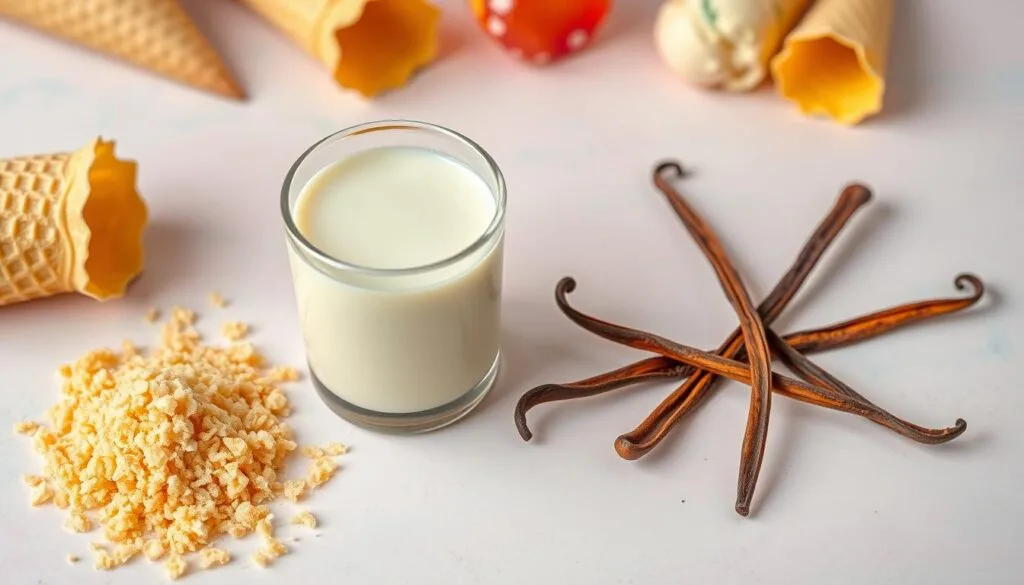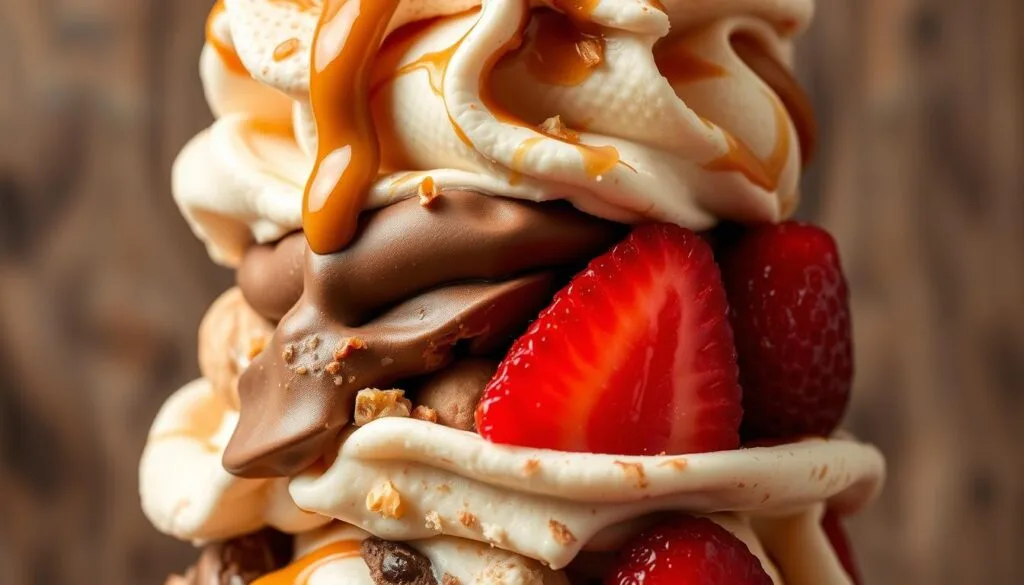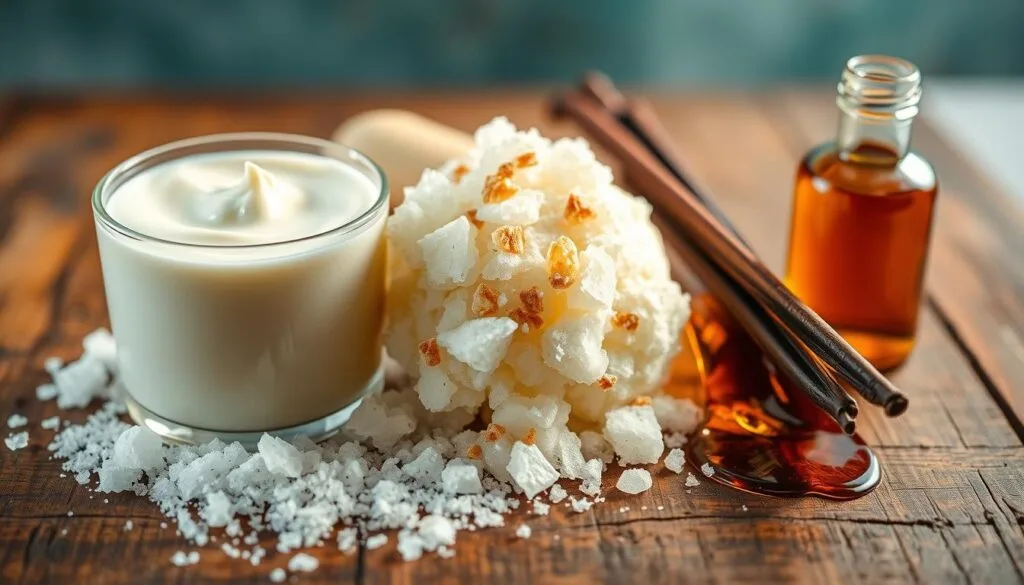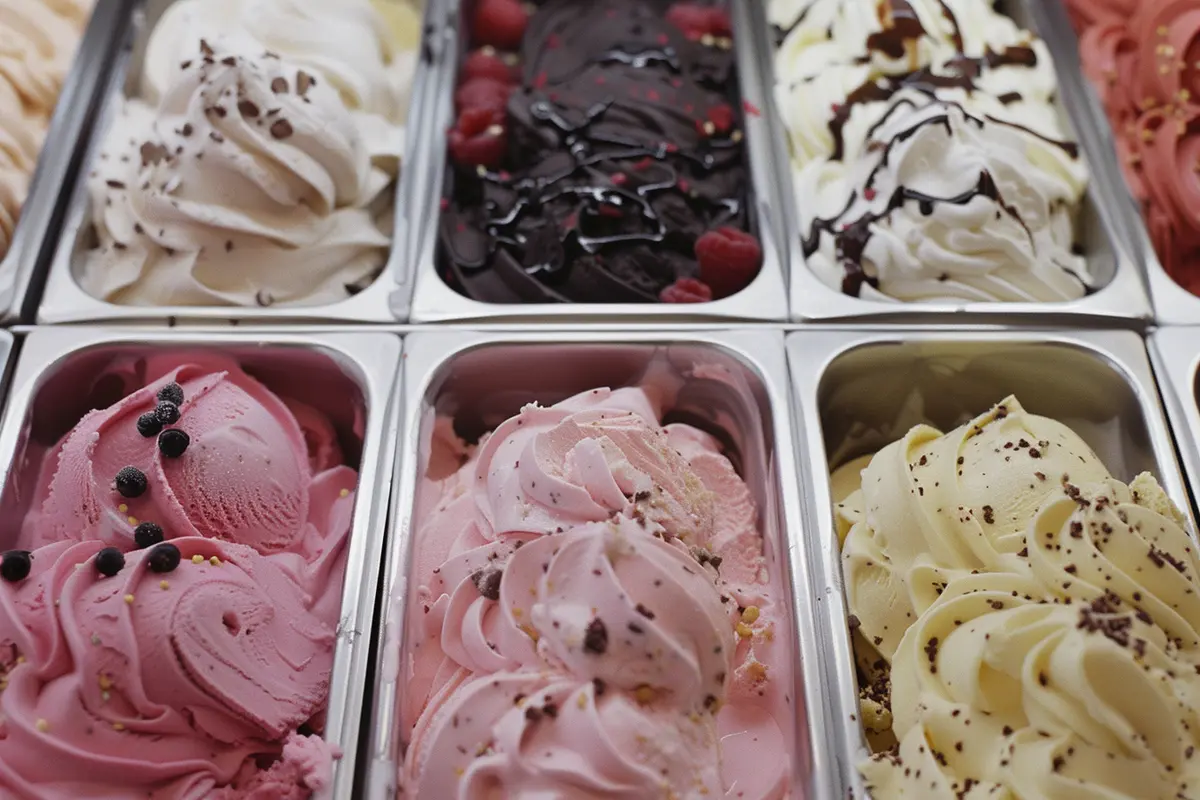Understanding the key ingredients for homemade ice cream is vital. See recipes that showcase the importance of these key ingredients. The right mix can make your ice cream creamy and smooth.
Making ice cream at home is fun and rewarding. It’s all about knowing the essential parts. With the right stuff and a bit of practice, you can make flavors that stand out.

Homemade ice cream is an art that needs a good grasp of its components. Discover tips for achieving the perfect creamy ice cream texture. With the right stuff and a bit of practice, you can make flavors that stand out.
Key Takeaways
- Understanding the essential ice cream components is crucial for making delicious homemade ice cream
- The right combination of ice cream ingredients can make all the difference in creating a creamy and smooth treat
- Creating homemade ice cream requires a basic understanding of the essential ice cream components
- Mastering the three most important ice cream ingredients can take your ice cream making skills to the next level
- Homemade ice cream can be a fun and rewarding experience with the right ingredients and practice
- Essential ice cream components are the key to creating unique and delicious flavors
The Art and Science of Ice Cream Making
Making the perfect ice cream is a mix of ice cream science and skill. Knowing the basics of ice cream’s texture and taste helps you make a creamy, tasty treat every time.

Understanding Ice Cream Structure
The ice cream structure is made up of air bubbles, ice crystals, and fat globules. Air makes it light, ice crystals make it smooth, and fat globules add richness and stability. This mix gives ice cream its velvety feel.
How Ingredients Work Together
Every ingredient is important in making ice cream, but what are the 3 most important ingredients of ice cream? Sugar sweetens and lowers the freezing point, stopping big ice crystals. Emulsifiers mix fat and water, creating a smooth base. Understanding what are the 3 most important ingredients of ice cream? helps you improve flavor and texture, making each scoop special.
The Role of Temperature
Temperature in ice cream making is key at every step. Cool temperatures help form the right ice crystals, and freezing keeps the texture right. Keeping the right temperature while storing keeps the ice cream fresh, preventing ice burn and flavor loss.
| Stage | Optimal Temperature | Effect on Ice Cream |
|---|---|---|
| Churning | -5°C to -10°C | Incorporates air and controls ice crystal size |
| Freezing | -18°C | Locks in texture and prevents large ice crystals |
| Storage | -20°C to -22°C | Maintains consistency and flavor integrity |
What Are the 3 Most Important Ingredients of Ice Cream?
Making the perfect scoop of ice cream needs three essential ice cream elements: dairy fat, sugar, and egg yolks. These main ice cream ingredients work together to give us the rich flavor and smooth texture we love.
- Dairy Fat: Provides creaminess and richness.
- Sugar: Adds sweetness and affects the texture.
- Egg Yolks: Enhance smoothness and stability.
Each key component of ice cream is crucial for the final product’s quality. Dairy fat makes it creamy, sugar sweetens and prevents ice crystals, and egg yolks make it velvety by mixing the ingredients.
Knowing these basic ingredients is key to mastering ice cream making. Next, we’ll explore how each element affects the making process.

| Ingredient | Role in Ice Cream |
|---|---|
| Dairy Fat | Creates creaminess and rich flavor. |
| Sugar | Adds sweetness and controls texture. |
| Egg Yolks | Enhances smoothness and stability. |
Dairy Fat: The Foundation of Creamy Ice Cream
The quality of dairy fat in ice cream is key to its creamy texture. Knowing about cream types and their milk fat content helps make the perfect dessert.

Heavy Cream vs. Light Cream
Heavy cream has 36-40% milk fat, perfect for a smooth ice cream base. Light cream, with 20% milk fat, makes ice cream slightly icier. The choice depends on how rich and creamy you want it.
Milk Fat Percentage Guidelines
Getting the right milk fat content is crucial for a smooth texture. Here are some guidelines for your recipes:
- Premium Ice Cream: 14-16% milk fat
- Regular Ice Cream: 10-12% milk fat
- Low-Fat Ice Cream: 5-7% milk fat
Alternative Dairy Options
For those who can’t have dairy, coconut cream or almond milk are great substitutes. They’re good for those with lactose intolerance and add unique flavors and textures.
| Cream Type | Milk Fat Content | Best For |
|---|---|---|
| Heavy Cream | 36-40% | Rich, creamy ice cream |
| Light Cream | 20% | Light and airy ice cream |
| Coconut Cream | 24-28% | Dairy-free, tropical flavors |
| Almond Milk | 1-2% | Low-fat, nutty ice cream |
Sugar: The Sweet Science Behind Ice Cream
Sugar in ice cream does more than just add sweetness. It plays a crucial role in determining the texture and overall quality of the frozen dessert.
The freezing point of ice cream is influenced by sugar’s role in frozen desserts. By lowering the freezing temperature, sugar helps create a smoother and creamier texture.
There are various sweeteners for ice cream, each impacting the flavor and consistency differently:
- Granulated Sugar: The most common sweetener, providing straightforward sweetness.
- Corn Syrup: Helps prevent large ice crystal formation.
- Honey: Adds a unique flavor profile while sweetening.
- Artificial Sweeteners: Ideal for those looking to reduce sugar content without sacrificing sweetness.
Balancing sweetness with other flavors is essential. Too much sugar can overpower the natural flavors, while too little can make the ice cream bland.
| Sweetener | Impact on Texture | Flavor Contribution | Suitability |
|---|---|---|---|
| Granulated Sugar | Smooth and creamy | Sweet, neutral | All traditional ice creams |
| Corn Syrup | Prevents ice crystals | Mild sweetness | Frozen desserts needing extra smoothness |
| Honey | Rich texture | Distinctive floral notes | Gourmet and artisanal ice creams |
| Artificial Sweeteners | Varies, often lighter | Sweet without calories | Low-sugar or diet ice creams |
Egg Yolks: Creating the Perfect Custard Base
Egg yolks are key to making a smooth ice cream custard base. They mix fats and liquids well, making the ice cream rich and flavorful.
Why Egg Yolks Matter
Egg yolks make ice cream creamy and luxurious. They keep the mixture stable and prevent ice crystals. This makes homemade ice cream very creamy.
Proper Tempering Techniques
Tempering eggs is important to avoid scrambled eggs. Warm milk is slowly added to the egg yolks while stirring. This careful step ensures a smooth custard base.
Eggless Alternatives
For those who can’t eat eggs, there are eggless options. Cornstarch or commercial stabilizers can do the job of egg yolks. They make the ice cream creamy and stable without eggs.
| Ingredient | Function | Benefits |
|---|---|---|
| Egg Yolks | Emulsifier | Creates creamy texture and stabilizes the custard |
| Cornstarch | Thickener | Provides smooth texture without using eggs |
| Commercial Stabilizers | Emulsifier and Thickener | Ensures consistency and prolongs shelf life |
Essential Equipment for Homemade Ice Cream
Making tasty ice cream at home begins with the right ice cream equipment. You need reliable ice cream makers that fit your needs.
- Manual Ice Cream Makers: Great for those who love making ice cream by hand.
- Electric Ice Cream Makers: Easy to use with built-in freezing bowls, perfect for quick batches.
- Compressor Ice Cream Makers: Top-notch machines for continuous ice cream making without pre-freezing bowls.
But ice cream makers aren’t the only thing you need. You’ll also need tools for making ice cream. A thermometer is key for tempering eggs and checking mixture temperatures. Also, airtight storage containers keep your ice cream fresh by preventing freezer burn.
Starting out or on a budget? You can still make ice cream without special equipment. Try the zip-lock bag method or a hand-crank for creamy results.
| Equipment | Purpose |
|---|---|
| Manual Ice Cream Maker | Hands-on churning for traditional texture |
| Electric Ice Cream Maker | Automatic churning for convenience |
| Thermometer | Accurate temperature monitoring |
| Airtight Containers | Prevent freezer burn and preserve freshness |
The Step-by-Step Ice Cream Making Process
Making ice cream is both fun and rewarding. Begin by preparing the base. Make sure all ingredients are well mixed for a smooth texture.
Preparing the Base
Mix your dairy, sugar, and any flavorings in a saucepan. If using eggs, cook the mixture gently. Stir constantly to create a rich custard.
Chilling Methods
Once the base is ready, chill it thoroughly. Place the mixture in the refrigerator for several hours or overnight. This step enhances flavor and improves texture.
Churning Tips
Proper ice cream churning techniques are crucial. Churn the mixture in your ice cream maker as instructed. For creaminess, add mix-ins like fruits, nuts, or chocolate chips towards the end.
If ice crystals form, ensure the base is fully chilled before churning. Consistent stirring and the right temperature are key to perfecting how to make ice cream.
Common Ice Cream Making Mistakes to Avoid
Making homemade ice cream is a fun process, but have you ever wondered, what are the 3 most important ingredients of ice cream? Knowing this can help you avoid some common issues. Understanding what are the 3 most important ingredients of ice cream? ensures you can fix problems and enjoy making ice cream even more.
Temperature Control Issues
Getting the temperature right is very important. If your base isn’t chilled enough, it won’t freeze well. Freezing too fast can also cause ice crystals. Make sure your mixture is well-chilled before you start churning.
Ingredient Ratio Problems
Getting the right mix of ingredients is crucial. Too much sugar can make it too sweet and affect freezing. Not enough fat can make it less creamy. Always follow recipes and measure ingredients carefully for the best taste and texture.
Storage Mistakes
Storing ice cream properly keeps it fresh longer. To avoid freezer burn, use airtight containers and keep the freezer at 0°F (-18°C). Here are some tips for storing ice cream:
| Tip | Description |
|---|---|
| Airtight Containers | Use containers that seal tightly to prevent air from entering. |
| Consistent Temperature | Maintain freezer temperature at 0°F (-18°C) for optimal storage. |
| Minimal Opening | Open the freezer as infrequently as possible to keep the temperature stable. |
| Flat Storage | Store ice cream in a flat layer to ensure even freezing. |
Creative Flavor Combinations and Add-ins
Exploring unique ice cream combinations can turn your homemade treats into something special. By trying different ice cream flavors and ice cream mix-ins, you can make desserts that people will remember.
- Salted Caramel and Pretzel Pieces
- Matcha Green Tea with White Chocolate Chips
- Lavender Honey with Almonds
- Spicy Chocolate with Chili Flakes
- Lemon Curd and Blueberry Swirls
When adding ice cream mix-ins, mix sweet and savory to boost taste and texture. Crunchy nuts with creamy bases or fruity swirls make a perfect mix that pleases the taste buds.
| Flavor Base | Mix-ins | Unique Combination |
|---|---|---|
| Vanilla Bean | Fresh Strawberries, Balsamic Glaze | Strawberry Balsamic Delight |
| Dark Chocolate | Sea Salt, Caramel Drizzle | Salted Caramel Chocolate Bliss |
| Coconut | Pineapple Chunks, Macadamia Nuts | Pina Colada Crunch |
| Honey Lavender | Shortbread Cookies, Lemon Zest | Lavender Lemon Biscuit |
FAQ
What are the essential ingredients for homemade ice cream?
The key ice cream ingredients are dairy fat, sugar, and egg yolks. Together, they create the creamy texture and flavor that homemade ice cream is known for.
How does dairy fat affect the texture of ice cream?
A: Dairy fat is crucial for a smooth homemade ice cream. It prevents ice crystals and makes the ice cream rich. The fat content, whether from heavy or light cream, greatly affects the texture.
What types of sugars can I use in ice cream making?
You can use different sugars and sweeteners in ice cream. Options include granulated sugar, brown sugar, honey, and alternatives like agave syrup or stevia. Each affects the sweetness and texture differently.
Can I make ice cream without using eggs?
Yes, you can! For those who can’t use eggs, alternatives like cornstarch, commercial stabilizers, or even avocado work well. They help keep the ice cream creamy without eggs.
What equipment do I need to make ice cream at home?
You’ll need an ice cream maker to make homemade ice cream. You can choose from hand-crank or electric models. Also, a thermometer and airtight containers are important for storage.
How do temperature and churning affect the final consistency of ice cream?
A: Temperature control is key in making ice cream. Chilling the base well before churning is essential for a smooth texture. The right churning technique also ensures a creamy consistency. Keeping the ice cream at the right temperature after making helps preserve its quality.
What are common mistakes to avoid when making ice cream?
Avoiding ice cream making mistakes is important. Not chilling the base enough can make it icy. Using too much sugar can make it too sweet. The right balance and freezing techniques are crucial.
How can I create unique flavor combinations in my ice cream?
Making unique ice cream flavor combinations is fun. Try adding mix-ins like fruits, nuts, or homemade sauces. Mixing different flavors and textures, like berries with chocolate or nuts with caramel, can create delicious ice cream.
What role do egg yolks play in the ice cream custard base?
A: Egg yolks are emulsifiers in the ice cream custard base. They blend fat and water smoothly. They also add richness and depth to the flavor and help keep the texture creamy.
Are there alternative dairy options for making ice cream?
Yes, there are alternative dairy options for ice cream. Options include coconut cream, almond milk, or soy milk. These alternatives are great for those with dietary restrictions and can still make delicious ice cream.
Conclusion: Mastering Your Ice Cream Creation
Creating homemade ice cream is a fun mix of art and science. If you’ve ever wondered, what are the 3 most important ingredients of ice cream?, the answer lies in balancing dairy fat, sugar, and egg yolks. These tips will help you make your ice cream even better.
Feel free to try new flavors and ingredients. Every batch you make helps you get better. Understanding what are the 3 most important ingredients of ice cream? allows you to perfect your recipes and enjoy consistently delicious results. Remember, practice and patience are your friends in this sweet adventure.
Love making ice cream that’s just right for you. There’s nothing like enjoying a scoop you made yourself. Start making ice cream with excitement and see how amazing it turns out.

